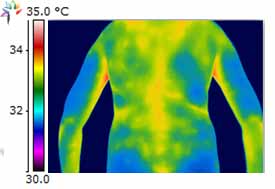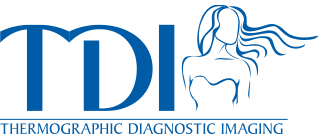The following are uses of full body thermography when anatomic tests (CT, myelogram and/or MRI) have not been performed, or are negative or inconclusive:
- To evaluate sensory/autonomic peripheral nerve injury
- To determine the possibility, or corroborate the clinical impression of Reflex Sympathetic Dystrophy (RSD) / Complex Regional Pain Syndrome (CRPS) or other autonomic dystrophy and to monitor the treatment of the disorder.
- To evaluate and monitor myofascial injury.
- To differentiate, document, and monitor any neuromuscular injury that does not respond to clinical treatment.
- To identify pain disorders that manifest without readily discernible signs or symptoms and to rule out symptom magnification.
- To evaluate facial or temporomandibular joint pain when other tests are inconclusive
If the tests of neurophysiology (thermogram and EMG) have been done first, and are negative, the need for anatomic testing may be reconsidered.
The following are uses of full-body thermography when anatomic tests (CT, Myelogram, and/or MRI) have been performed and are positive:
- To evaluate the significance of positive findings when the physical exam or history do not coincide, i.e., a lesion may be present anatomically but have no significance physiologically.
- To look for hidden or missed lesions. Examples:
- The CT may be abnormal at one level, but the thermogram may show abnormality at this and an adjacent level, leading the physician to order another test, such as a myelogram or MRI, which may uncover a second lesion.
- The patient may have nerve dysfunction and Reflex Sympathetic Dystrophy/Complex Regional Pain Syndrome, with only one set of presenting symptoms.
- The patient may have both nerve problems (disc), and trigger points or facet joint problems, with overlapping or masking of symptoms. Under these circumstances, history and/or symptoms can be masked by the predominant lesion.
- To evaluate the significance of equivocal or mild disc bulges or herniations on myelograms, CT or MRI scans if clinically indicated.
- To evaluate for the possibility of Reflex Sympathetic Dystrophy/Complex Regional Pain Syndrome, and to monitor the treatment if clinically indicated.
- Differentiate, document, and monitor any neuromuscular injury that does not respond to clinical treatment.
What’s Included in This Combination?
Breast Thermography
- Bilateral imaging of the breasts in multiple positions
- Early detection of thermal asymmetries, vascular activity, and lymphatic congestion
- Useful for preventive screening, monitoring fibrocystic or dense breasts, and post-surgical follow-up
- Safe for all ages—no radiation or compression

Facial–Dental–Thyroid Thermography
- High-resolution thermal imaging of:
- Forehead & sinuses
- Jawline & dental arches
- Neck & thyroid region
- Ideal for screening:
- Low-grade dental infections (often asymptomatic)
- Sinus inflammation
- TMJ or jaw stress
- Thyroid inflammation or asymmetry
Upper Body Thermography
- Full Back & Spine
- Upper Back (Zoomed View)
- Abdomen & Lower Torso (excluding the chest or breast region)
- Arms and Hands (Bilateral)

Lower Body Thermography
- Full Back including Thoracic, Lumbar and Sacral Spine
- Lower Back (Zoomed-In)
- Front and Back of Thighs & Knees
- Calves, Ankles, and Shins
- Feet (Plantar and Dorsal views)
Full Body includes all 4 scans, each with a unique report.
Sample Thermal Breast Imaging Report Sample Thermal Cranial Dental Imaging Report Sample Thermal Upper Body Imaging Report Sample Thermal Lower Body Imaging Report
